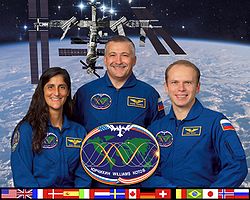Expedition 15
| Expedition 15 | |||
 | |||
| Uppdragsstatistik | |||
|---|---|---|---|
| Rymdstation: | ISS | ||
| Start: | 7 april 2007 | ||
| Slut: | 21 oktober 2007 | ||
| Tid: | 199 dagar, 17 timmar och 17 minuter | ||
| Antal besättningsmedlemmar: | 3 st | ||
| Rymdpromenad | |||
| Antal rymdpromenader: | 3 st | ||
| Total tid: | 18 timmar, 43 minuter | ||
| Transport | |||
| Uppskjutning: | 7 april 2007 & 8 juni 2007 med Sojuz TMA-10 & Atlantis STS-117 | ||
| Uppskjutningsplats: | Kosmodromen i Bajkonur Kennedy Space Center | ||
| Landning: | 12 oktober 2007 & 3 november 2007 med Sojuz TMA-10 & Discovery STS-120 | ||
| Landningsplats: | Kazakstan, Kennedy Space Center | ||
| Kronologi | |||
| |||
Expedition 15 var den 15:e expeditionen till den Internationella rymdstationen (ISS). Två besättningsmedlemmar (Fjodor Jurtjichin och Oleg Kotov) sköts upp från Kosmodromen i Bajkonur, den 7 april 2007 ombord Sojuz TMA-10. De anslöt då till Sunita Williams som anlänt i december 2006 med STS-116, då tillhörande Expedition 14. I juni 2007 ersatte Clayton Anderson Williams som den tredje besättningsmedlemmen. Williams återvände till jorden med STS-117.
Besättningen

Från vänster: Williams, Jurtjichin, Kotov

Från vänster: Anderson, Jurtjichin, Kotov
| Position | Första delen (7 april - juni 2007) | Andra delen (juni - 21 oktober 2007) |
|---|---|---|
| Befälhavare | Hans andra rymdfärd | |
| Flygingenjör 1 | Hans första rymdfärd | |
| Flygingenjör 2 | Hennes första rymdfärd | Hans första rymdfärd |
(#) antal rymdfärder som varje besättningsmedlem avklarat, inklusive detta uppdrag.
Rekord för kvinnliga astronauter
När Sunita Williams landade med STS-117 blev hon den kvinna som dittills varit längst i rymden. Med 195 dagar i rymden passerade hon därmed Shannon Lucids tidigare rekord på 188 dagar från 1996. Williams innehade även rekordet för rymdpromenader utförda av en kvinna, med 4 rymdpromenader på sammanlagt 29 timmar och 17 minuter.
| |||||||||||||||||||
Media som används på denna webbplats
This patch commemorates the sixteenth expeditionary mission to the International Space Station (ISS). The design represents the conjunction of two unique astronomical events: a transit of the ISS across the surface of a full moon, and a nearly complete annular eclipse of the sun. The ISS is shown in its complete configuration, symbolizing the role of this expedition in preparing for the arrival and commissioning of international partner modules and components. The ISS transit across the moon highlights its role in developing the techniques and innovations critical to enable long-duration expeditions to the lunar surface and beyond.
Expedition 15 commander Fyodor Yurchikhin (center), flight engineer Oleg Kotov (right), and flight engineer Sunita Williams pose for a crew portrait
This emblem embodies the past, present, and future of human space exploration. The Roman numeral XIV suspended above the Earth against the black background of space symbolizes the fourteenth expeditionary mission to the International Space Station (ISS), or Международная Космическая Станция. Elements of this symbol merge into a unified trajectory destined for the moon, Mars, and beyond, much as science and operations aboard the ISS today will pave the way for future missions to our celestial neighbors. The five stars honor the astronauts and cosmonauts of missions Apollo 1, Soyuz 1, Soyuz 11, Challenger, and Columbia, who gave their lives in the pursuit of knowledge and discovery.
The operational teamwork between human space flight controllers and the on-orbit crew take center stage in this emblem. Against a backdrop familiar to all flight controllers, past and present, independent of any nationality, the fifteenth expedition to the ISS is represented in Roman numeral form as part of the ground track traces emblazoned on the Mercator projection of the home planet Earth. The ISS, shown in its fully operational, assembly complete configuration, unfurls and then reunites the flags of this Russian and American crew in a show of our continuing international cooperation. Golden spheres placed strategically on the ground track near the flight control centers of the United States and Russia serve to symbolize both the joint efforts from each nation's team of flight controllers and the shuttle and Soyuz crew vehicles in their chase orbit as they rendezvous with the ISS. A rising sun provides a classic touch to the emblem signifying the perpetual nature of manned space flight operations and their origin in these two space-faring nations.
Expedition 15 crewmembers posed for photos at the conclusion of a Dec. 13 press conference at the Johnson Space Center. From the left are astronaut Clayton C. Anderson, flight engineer; along with cosmonauts Oleg Kotov, flight engineer and Soyuz commander; and Fyodor Yurchikhin, commander. Kotov and Yurchikhin represent Russia's Federal Space Agency.






